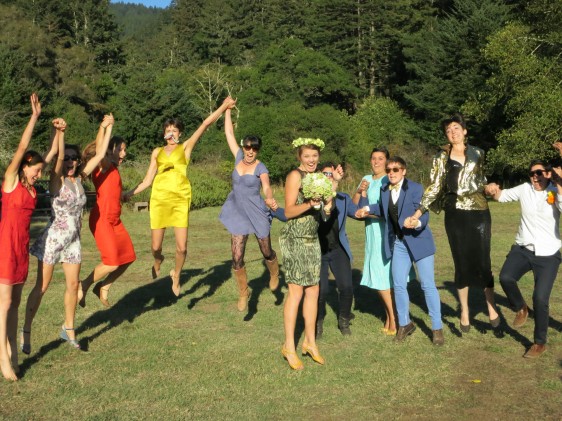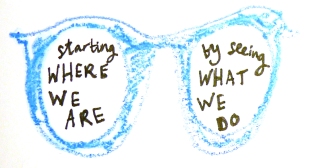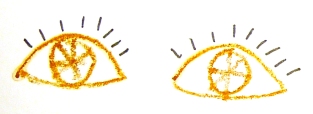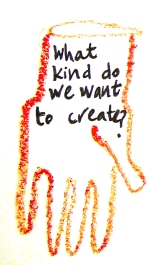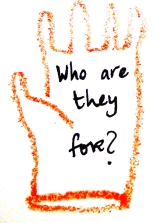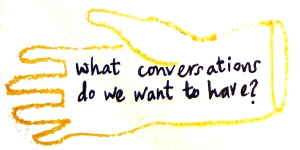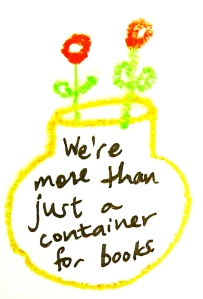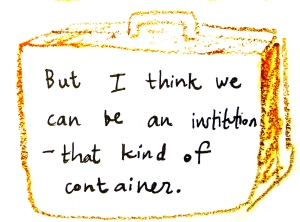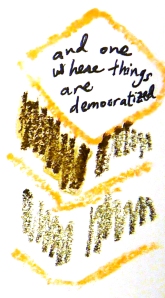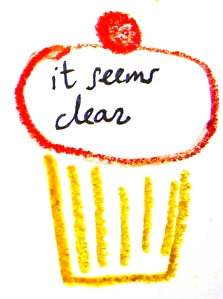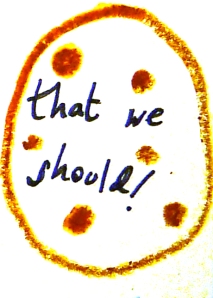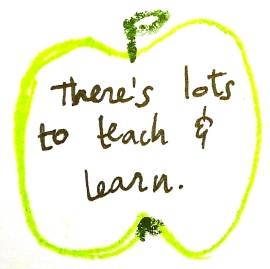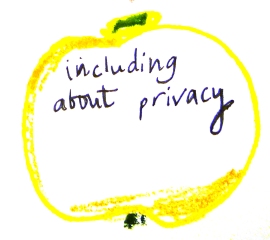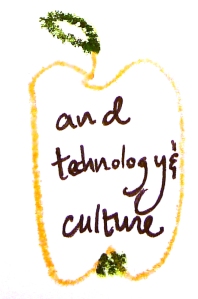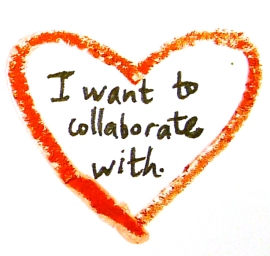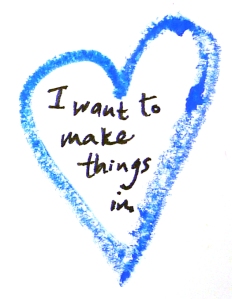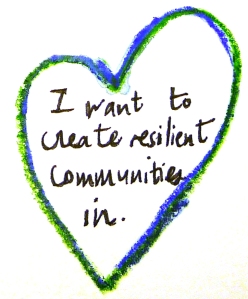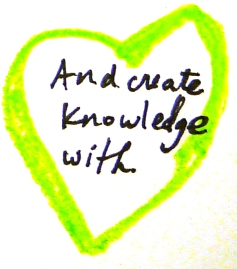Background
3D printers have been used for decades for rapid prototyping. “Essentially, a 3D printer is a machine that can turn a blueprint into a physical object” (Weinberg, 2010). They do so through additive manufacturing, another name for 3D printing (Freedman, 2012), in which layers of fast-hardening materials such as plastic, resin, or even chocolate are deposited precisely using a digital file to direct the form it takes.

The first 3D printer
The first 3D printer was designed by Charles Hull of 3D Systems Corporation, and used a stereolithography technique, which hardens layers of thermoplastic with a laser (Knowles, 2012). Other methods include using powder and lasers in a selective layer sintering method.
The term “3D printing” was invented by grad students Tim Anderson and Jim Bredt, who reconfigured an inkjet printer to “print” binding solution onto powder in 1995 (Knowles). This was the beginning of the “hobbyist” versions of the printer. Today, there are many companies which create “desktop” versions of 3D printers, such as , MakerBot (Brooklyn, NY based), Shapeways (based in the Netherlands), and FormLabs. Prices range from $700 – $20,000, with prices dropping and innovations increasing all the time.

MakerBot’s Replicator 2
Most of the desktop versions print in Polylactic Acid (PLA) or Acrylonitrile Butadiene Styrene (ABS) filament, which are thermoplastics – they melt at high heat (Wyoming State University, 2013). They print from digital files called CADs, for computer assisted design, which can be created in a variety of software. Popular ones include Google’s open-source SketchUp program, which is fairly user friendly. Here is an example of a CAD drawing or model from Thingiverse.

CAD drawing of a Christmas Tree

Filament
The companies that make the hobbyist printers often also have forums where users can upload models, comment, and download models for free such as this from Shapeways or Thingiverse from MakerBot.
Understanding the issues
3D printers are a quickly emerging technology, with more and more libraries purchasing them. In an article by Knowles (2012), Maxim Lobovsky, who co-founded for FormLabs, sees the printer as revolutionary. “Our desktop printer encourages a more grass roots movement. … Just like the PC revolution spawned an increase in all sorts of software development and new uses for computers.” Their rise has been compared to early PC development days, they are seen as the start of new manufacturing system and style, as well as a creative boon. Weinberg (2013) says “The ability to reproduce physical objects in small workshops and at home is potentially just as revolutionary as the ability to summon information from any source onto a computer screen” (2013). In this section, this brief will explore negative issues and affordances of this emerging technology.
Negative issues
Technolust and mission creep
One of the main issues with 3D printers is determining if they are truly tools that a library should have, or if they are simply a fad and unnecessary purchase. Rundle (2013) wrote a scathing article against libraries purchasing them, saying that their use in a public library constitutes mission creep deviation from mission statement): “The harsh truth is that there is no business case for public libraries to provide 3D printing. What this is really about is technolust and the fear of being left behind.” They are quite expensive, and also require dedicated staff to manage them.
In Stephens (2004), technolust and mission creep are clearly defined:
We may know that technology is not an end in itself but a tool to help us meet our libraries’ service goals, but that’s easy to forget. After all, technology often sucks up huge amounts of attention, money, and staff resources. Our users, also technology consumers, have evolving expectations of what the library should provide. Yet new technologies can be disruptive to both staff and public. Added to all this, some of us remain technophobes while others are consumed by technolust – an irrational love for new technology combined with unrealistic expectations for the solutions it brings.
Without realistic expectations of how 3D printers support the library’s mission, they can lead to mission creep.
Cost and staffing
3D printers are quite expensive, with costs ranging from $700-$2200 or more. They also require design skills, software, and staffing to maintain. Because 3D printers are an emerging technology, cost analyses, guidebooks, and models are also emerging. Another element of cost or return on investment is how much a community will use them:“If a public library does not have a tech-savvy community that will be responsive to a Maker Space, then creating one will likely be a waste of money. Even at its lowest prices, 3D printing is an expensive technology and 3D printers are definitely a purchase that needs to be justified” (Groenendyk, n.d.).
Legal issues
Legal barriers to printing in 3D are just beginning to be explored. For instance, when a man printed a few figurines in the style of the game Warhammer, he was forced to take down his model from the Thingiverse websites, Makerbot’s 3D model website (Thomson, 2012). Just like using information that is copyrighted must be properly understood, so does printing physical objects based on copyrighted material. Currently, manufacturers laws are not powerful enough to control 3D printing, though some experts say that laws as heavy-handed as the Stop Online Piracy Act may be on their way if not controlled. (Weinberg, 2013).
Health issues

Table from the 2013 study.
In a recent study from the Illinois Institute of Technology, results showed that “… caution should be used when operating some commercially available 3D printers in unvented or inadequately filtered indoor environments. Additionally, more controlled experiments should be conducted to more fundamentally evaluate aerosol emissions from a wider range of desktop 3D printers and feedstocks” (Stephens, Azimi,, El Orch, & Ramos, 2013, p. 339). The researchers were concerned with the lack of data on the health hazards of 3D printers, in context of the hazards demonstrated by industrial 3D printers. Monitoring research and recommendations for the health hazards of 3D printers must continue.
Affordances
Mission statement support
The idea that 3D printers constitute mission creep is very controversial. Rundle’s 2012 article, which posited that 3D printers have no place in the library, created many responses, most of which disagreed with him. Gass (2013) believed that 3D printers are here to stay, and that libraries need to participate in their emergence in order to stay relevant to our communities. Lankes (2013) absolutely disagrees with Rundle.
The point is not for folks to come in and print out existing things, but to create their own things (and ideas, and new products, and pieces of whimsy). Why in a library? Because that is the core of the library – not the collection – idea creation and knowledge generation. Those books and stacks, and printers, and bathrooms, and study rooms, and tape players, and microfiche readers are just tools to get at what librarians are really supposed to be doing…helping the community create knowledge and know itself.
He does agree with Rundle in that getting a 3D printer for no reasons other than it’s tech appeal is technolust.
By supplying 3D printers, libraries help people have access to a technology that is rapidly emerging as an important one. “One of the most important mandates for public libraries has been to provide equal access to information and knowledge. 3D printing, 3D scanning and other Maker Space technologies have the potential to drastically change the world, yet it is very difficult for most people to gain access to these technologies” (Groenendyk, n.d.). Groenendyk also sees 3D printers as a way to reach a segment of the community that may otherwise not be visiting the library: the tech community and maker community.
Content creation
The debate about mission creep comes down to whether or not libraries should support content creation, or stick to content preservation and dissemination. Library trends show that content creation is an important part of offering 21st century services. “[3D Printer] technology fits in about as neatly as book discussions, resume workshops, technology instruction, and children’s crafts- all standard practice in many public libraries. These types of services are not about content or information dissemination; they are about what you do with it. They involve some form of digesting, synthesizing, and creating, all within a community context” (Gass, 2013). 3D printers often appear in libraries’ Maker Spaces, which are collaborative spaces for creation, and can electrify a community’s ability to make art, news, or other media.
The Maker movement also meets other aspects of many library mission statements, which is to be connected to 21st century skills and media literacies. “Making in the 21st century has moved out of the individual workshop and gone networked. Today’s tinkerer work in vast, distributed communities where information sharing is the norm, where the ethics and practices of the free/open source software movement has gone physical” (Doctorow, 2013). When a library can support the Maker movement, it can access and learn from these communities.
Use
3D printers are still most often used as rapid prototyping devices industrially. In the manufacturing world, are also used to create prostheses, bones, and stem cells, or other consumer products like shoes and guitars (Boboltz, 2013). However, in a library, a 3D printer more often functions as a tool for hobbyists or individuals, and the uses vary further.

A bone created with a 3D printer.
http://www.youtube.com/watch?feature=player_embedded&v=XEKns8T7yUA
Maker spaces are the main homes of 3D printers in libraries. Gutsche (2002), defines maker spaces:
Making is about participatory learning, about learning and exploring the creative process collaboratively and physically aligns with a global progression from the Information Age to the Imagination Age, to a culture that, as John Seely Brown posits, is receptive to learning anywhere, anytime through playing, tinkering, making, and doing. Makerspaces embody this transformation, and libraries are positioned to be at its hub.
Maker spaces are cropping up across the country, and many have 3D printers as well as media labs for video production, art and craft areas, computer software for digital arts, and more. Libraries are part of this movement, and will only continue to do so – Maker spaces have the support of the American Library Association and the Institute for Museum and Library Services (IMLS).
3D printers in libraries have been used to create replacement parts for machinery or equipment (such as a lawn mower wingnut), as well as fun toys and art pieces. The most popular models to download on Thingiverse include a carabineer, luggage tag, pencil pot, and model of a seaturtle (Thingiverse, n.d.).

Carabiner model
Background research and studies
To address legal issues, the white paper “It Will Be Awesome if They Don’t Screw it Up: 3D Printing, Intellectual Property, and the Fight Over the Next Great Disruptive Technology” by Weinberg gives an excellent overview of the technology’s legal future. It attempts to “prepare the 3D printing community, and the public at large, before incumbents try to cripple 3D printing with restrictive intellectual property laws. By understanding how intellectual property law relates to 3D printing, and how changes might impact 3D printing’s future, this time we will be ready when incumbents come calling to Congress.” Public Knowledge’s interest in the subject will surely create more research.

The 4th Floor is building a new 3D printer to keep up with demand
There are many famous Maker Spaces which use 3D printers that can be used as models. Examples include the Fayetteville Library’s Fab Lab, Chattanooga’s 4th Floor, Tech Central at the Cleveland Public Library, Westport Public Library, and many more. These spaces are the vanguard of the 3D printer in library trend, and should be watched.
Make Magazine features research, ideas, and articles on Maker spaces and creations. They partner with libraries as well. Another source is the American Library Association funded Make It at Your Library website, which features ideas for makerspace projects.

A project from the Make it at Your Library: DIY Smartphone Film Scanner
The Institute for Museum and Library Services (IMLS) has an excellent list of talking points about Maker spaces as well, with a focus on science, math, engineering, and technology. As a granting institution, they publish lists of innovative learning labs and Maker spaces that they have funded. They also publish white papers on 21st Century Learning, which is research that can be used to support the creation of a maker space or purchase of 3D printer. The American Library Association hosts a Maker Monday at their annual conference, which can be a source for ideas and models.

Yoda heads from Maker Monday
Successful implementation of 3D printers
3D printers are an emerging technology. Like all emerging technologies, care must be taken to implement them prudently and intentionally to avoid unnecessary risks and costs, and to preserve the integrity of the library.
To access funding, IMLS grants, including the Sparks! Ignition Grants for Libraries and Museums, have funded many Maker spaces. In 2013 awarded $496,978 to “test and evaluate innovations in the ways they operate and the services they provide” (Institute for Museum and Library Services, n.d.). Libraries also charge users to use the printer: for instance, at Dalhousie Libraries, they charge $1/minute (American Library Association, n.d.)
Firstly, the community must be interested in technology, or have programs that can get the community interested, such as youth programs or training. When the community needs have been evaluated, and users have been surveyed and found to be interested in a 3D printer, that is the time to be part of the 3D printer emergence. Next, libraries must have a tech-savvy staff and administration to be able to implement 3D printers well. At least one dedicated staff should manage the implementation and use of the printer, and conduct innovative training to energize staff. When the technology feels like part of a larger movement within the library, it will be successful. The 3D printer’s contribution to the library’s mission statement must be demonstrated. The library must believe in its mission statement, and its mission statement and brand must be more than just warehousing books – there should be a focus on supporting multiple literacies and being open to the needs of the community. With staff buy-in and participation, and community energy, a 3D printer could be part of a vibrant library.
To download the annotated bibliography click here.
Sources cited
American Library Assocition (n.d.). 3D Printing. Transforming Libraries. http://www.ala.org/transforminglibraries/3d-printing-dalhousie-libraries
Boboltz, S. (2013, November 15). 11 amazing ways people are using 3D printers for good, not guns. The Huffington Post. Retrieved from http://www.huffingtonpost.com/2013/11/15/3d-printer-inventions_n_4262091.html
Britton, L. (2012). A Fabulous Laboratory. Public Libraries, 52(4), 30-33.
Doctorow, C. (2013, February 24). Libraries, hackspaces and e-waste: how libraries can be the hub of a young maker revolution [Web log post]. Raincoast Books. Retrieved from http://www.raincoast.com/blog/details/guest-post-cory-doctorow-for-freedom-to-read-week/
Freedman, D. H. (2012). Layer by Layer. Technology Review, 115(1), 50-53.
Gass, Nate (2013, January 30). Do 3D Printers belong in libraries? [Web log post]. Nate’s Broadcast. Retrieved from http://www.natesbroadcast.com/journal/do-3d-printers-belong-in-libraries-a-defense
Gutsche, B. (2002). Makerspaces in Libraries: Patron’s Delight, Staff’s Dread? Alki.29(1), 28-30.
Institute for Library and Museum Services (2012). Talking Points: Museums, Libraries, and Makerspaces. Institute for Library and Museum Services. Retrieved from http://www.imls.gov/assets/1/AssetManager/Makerspaces.pdf
Institute for Library and Museum Services (n.d.). Fast Facts: Sparks Ignition Grants. Institute for Library and Museum Services. Retrieved from http://www.imls.gov/recipients/fast_facts_sparks_ignition_grants.aspx
Knowles, J. (2012). Behind the Rise of the 3D Printing Revolution. The Next Web. Retrieved from http://thenextweb.com/insider/2012/12/08/behind-the-rise-of-the-3d-printing-revolution/
Lankes , D. (2013, January 3). Beyond the bullet points: Missing the point and 3D printing [Web log post]. Virtual Dave…Real Blog. Retrieved from http://quartz.syr.edu/blog/?p=2538
Rundle, H. (2013, January 2). Mission creep – a 3D printer will not save your library [Web log post]. It’s not about the books: libraries, technology, information, stories. Retrieved from http://hughrundle.net/2013/01/02/mission-creep-a-3d-printer-will-not-save-your-library/
Stephens, B., Azimi, P., El Orch, Z., & Ramos, T. (2013). Ultrafine particle emissions from desktop 3D printers. Atmospheric Environment, 79334-339. doi:10.1016/j.atmosenv.2013.06.050
Stephens, M. (2004). Technoplans vs. technolust. Library Journal, 129(18), 36-37.
Thingiverse (n.d.). Explore: popular. Thingiverse. Retrieved November 20, 2013 from http://www.thingiverse.com/explore/popular
Thompson, C. (2012, May 30). Clive Thompson on 3-D printing’s legal morass [Web log post]. Wired. Retrieved from http://www.wired.com/design/2012/05/3-d-printing-patent-law/
Weinberg, M. (2013). It Will Be Awesome if They Don’t Screw it Up: 3D Printing, Intellectual Property, and the Fight Over the Next Great Disruptive Technology [White paper]. Public Knowledge. Retrieved from http://www.publicknowledge.org/it-will-be-awesome-if-they-dont-screw-it-up
Wyoming State Library [wyomingstatelibrary]. (2013, October 13). 3D printing and libraries [Video file]. Retrieved from http://youtu.be/FtoZVqTXp_4
